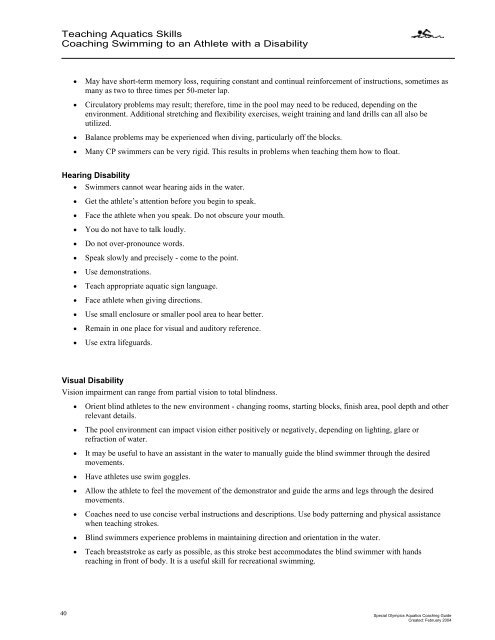Aquatics Coaching Guide - Special Olympics
Aquatics Coaching Guide - Special Olympics
Aquatics Coaching Guide - Special Olympics
You also want an ePaper? Increase the reach of your titles
YUMPU automatically turns print PDFs into web optimized ePapers that Google loves.
Teaching <strong>Aquatics</strong> Skills<br />
<strong>Coaching</strong> Swimming to an Athlete with a Disability<br />
40<br />
May have short-term memory loss, requiring constant and continual reinforcement of instructions, sometimes as<br />
many as two to three times per 50-meter lap.<br />
Circulatory problems may result; therefore, time in the pool may need to be reduced, depending on the<br />
environment. Additional stretching and flexibility exercises, weight training and land drills can all also be<br />
utilized.<br />
Balance problems may be experienced when diving, particularly off the blocks.<br />
Many CP swimmers can be very rigid. This results in problems when teaching them how to float.<br />
Hearing Disability<br />
Swimmers cannot wear hearing aids in the water.<br />
Get the athlete’s attention before you begin to speak.<br />
Face the athlete when you speak. Do not obscure your mouth.<br />
You do not have to talk loudly.<br />
Do not over-pronounce words.<br />
Speak slowly and precisely - come to the point.<br />
Use demonstrations.<br />
Teach appropriate aquatic sign language.<br />
Face athlete when giving directions.<br />
Use small enclosure or smaller pool area to hear better.<br />
Remain in one place for visual and auditory reference.<br />
Use extra lifeguards.<br />
Visual Disability<br />
Vision impairment can range from partial vision to total blindness.<br />
Orient blind athletes to the new environment - changing rooms, starting blocks, finish area, pool depth and other<br />
relevant details.<br />
The pool environment can impact vision either positively or negatively, depending on lighting, glare or<br />
refraction of water.<br />
It may be useful to have an assistant in the water to manually guide the blind swimmer through the desired<br />
movements.<br />
Have athletes use swim goggles.<br />
Allow the athlete to feel the movement of the demonstrator and guide the arms and legs through the desired<br />
movements.<br />
Coaches need to use concise verbal instructions and descriptions. Use body patterning and physical assistance<br />
when teaching strokes.<br />
Blind swimmers experience problems in maintaining direction and orientation in the water.<br />
Teach breaststroke as early as possible, as this stroke best accommodates the blind swimmer with hands<br />
reaching in front of body. It is a useful skill for recreational swimming.<br />
<strong>Special</strong> <strong>Olympics</strong> <strong>Aquatics</strong> <strong>Coaching</strong> <strong>Guide</strong><br />
Created: February 2004
















